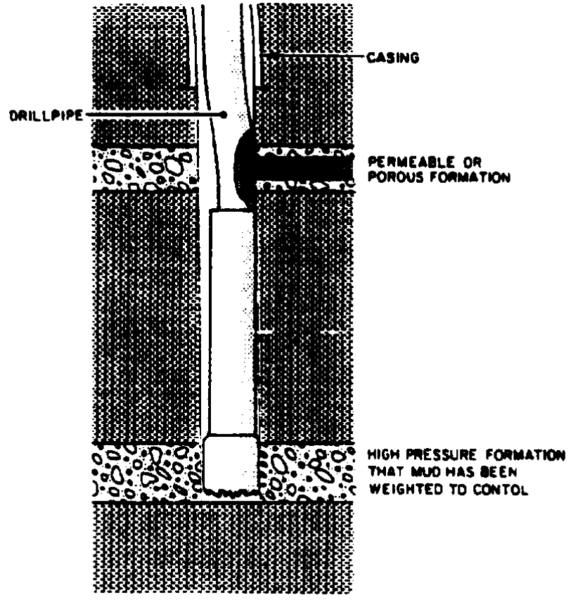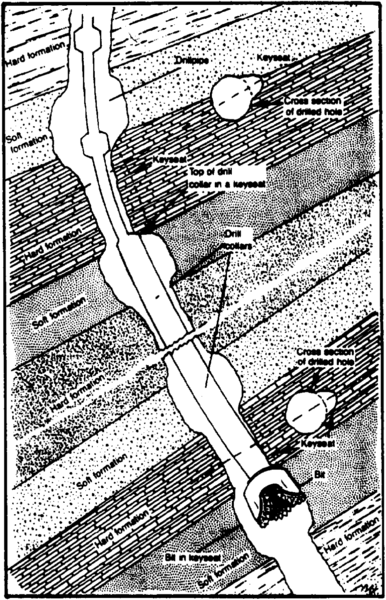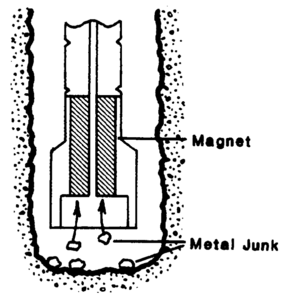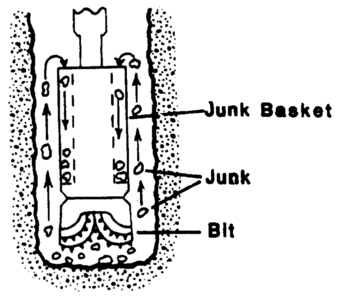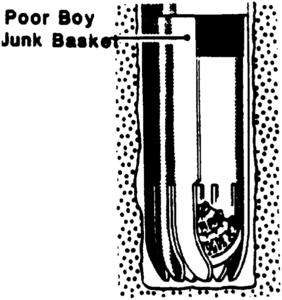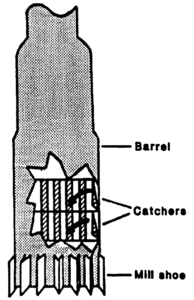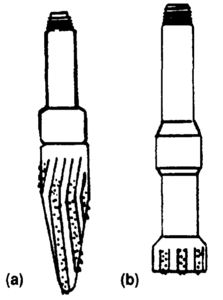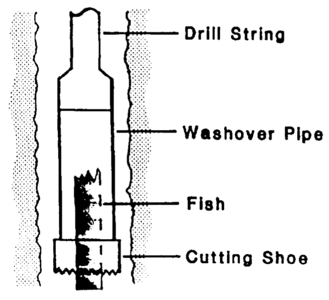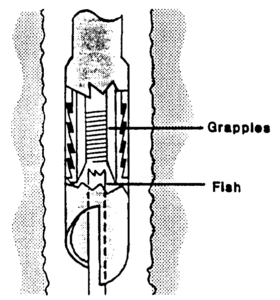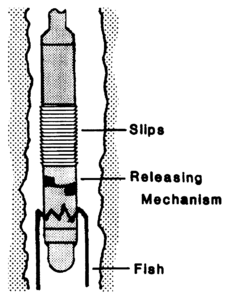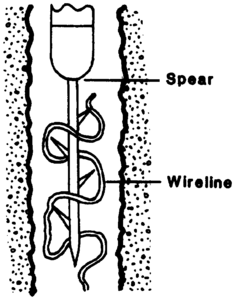Fishing
| Development Geology Reference Manual | |

| |
| Series | Methods in Exploration |
|---|---|
| Part | Wellsite methods |
| Chapter | Fishing |
| Author | Arnold M. Woods |
| Link | Web page |
| Store | AAPG Store |
Reasons for fishing
Figure 1 Differential sticking. ©Exploration Logging[1]
Figure 2 Key seating. © Short;[2] courtesy of PennWell Books.
Fishing (in the oilfield sense) refers to the recovery of unwanted material left in the wellbore. Numerous situations can occur that require fishing:
- Items dropped into the hole from the rig floor.
- Failure of surface equipment, especially pumps, which allows the hole to cave in and stick the drill string.
- Differential sticking to a permeable formation (Figure 1).
- Key seating, where a slot is worn into the wall of the well (Figure 2).
- Twist-offs resulting from a stuck drill string being rotated until the pipe shears above the sticking point.
- Loss of portions of downhole equipment, such as stabilizer fragments and bit cones.
- Drill string failure from such causes as metal fatigue, H2S embrittlement, differential sticking, and overstressed drilling assembly, causing a twist-off.
- Pulling the drill string apart when trying to free stuck pipe.
- Bridging off by swelling formations or a collapsed hole.
When material is left in the hole due to these or other factors, a decision must be made whether to try to recover the material, to sidetrack around the original material, to abandon the well, or to attempt to complete in a shallower zone. Because all but the first of these options are costly, and the last is often undesirable, an attempt to recover the fish is almost always made.
Types of fishing tools
Many specialized tools have been developed to address specific types of recoveries. In general, fishing tools fall into two categories: those used to recover small items (junk) and those used to recover larger items such as drill pipe.
Common junk fishing tools
Magnet
A magnet is used to recover small metal pieces from the hole, such as bit cones (Figure 3).
Junk or boot basket
A “junk” or “boot” basket is run just above the bit and catches small pieces of junk thrown up by turbulence. It is often part of the BHA, and it is almost always run before a core barrel or diamond bit to prevent damage (Figure 4).
Poor boy junk basket
Often made at the wellsite, a “poor boy” junk basket consists of a small section of casing with beveled “fingers” cut into the end. The basket is lowered on the drill string where it cuts a small core. More weight is applied to the tool, bending the fingers in and snaring the core containing the junk (Figure 5).
Core type basket
A core type basket consists of a barrel with a mill shoe and two sets of internal catchers. The basket is slowly rotated onto the junk in the hole where it cuts a small core. The catchers hold the core while the tool is retrieved (Figure 6).
Tools commonly used to retrieve drill pipe and logging tools
Jars
Jars are hydraulic or mechanical tools that provide a sudden, powerful upward (oil jar) or downward (bumper jar) stroke on the drill string. A typical jarring set up would include a catching tool, bumper jar, oil jar, drill collars, and drill string. Drilling jars (specially strengthened jars) are commonly run in the drill string in case the drill string becomes stuck. In a fishing job, the jars are run just above the fishing tool.
Mill
Before some fish can be recovered, it is necessary to “dress” the top, that is, to grind the uneven top to a shape that the fishing tool can grasp, or to clear and open the inside of the fish. To do this, either a flat or a tapered mill bit is used (Figure 7). The mill bit has tungsten carbide abrasive surfaces that can trim the fish to the desired shape.
Washover
Washover equipment consists of casing with a cutting shoe. It is run over the fish to clear away debris before the fishing tool is run (Figure 8). Washing over is often done to free key-seated or differentially stuck pipe.
Overshot
The most common and widely used tool, the overshot consists of a large diameter, open mouth pipe with a tapered tap or die, or, more commonly, with a set of slips that grab the outside of the fish when the assembly is lifted and prevent its release (Figure 9).
Pipe spear
Like an overshot, a pipe spear is used to recover large tubulars, but it instead attaches to the inside of the fish via a set of slips that are extended after the spear is inserted (Figure 10).
Wireline spear
A wireline spear is a simple spear with barbs used to hook parted wireline (Figure 11).
Freeing stuck pipe
Before a stuck pipe becomes a fishing job, several procedures can be used to free it. These include the following:
- Jarring on the stuck pipe until it loosens
- Placing oil or chemicals (such as surfactants) in the hole to reduce intersurface tension
- Displacing part of the mud with a lighter fluid to reduce hydrostatic pressure, which is particularly effective for differentially stuck pipe
See also
- Drilling problems
- Mudlogging: Drill cuttings analysis
- Introduction to wellsite methods
- Wellbore trajectory
- Conventional coring
- Drilling fluid
- Land rigs
- Rig personnel
- Wellsite math
- Core handling
- Mudlogging: Equipment, services, and personnel
- Core alteration and preservation
- Wellsite safety
- Sidewall coring
- Show evaluation
- Rate of penetration
- Mudlogging: The mudlog
- Well planning
- Pressure detection
- Drill stem testing
- Measurement while drilling
- Offshore rigs
- Core orientation
- Mudlogging: Gas extraction and monitoring
